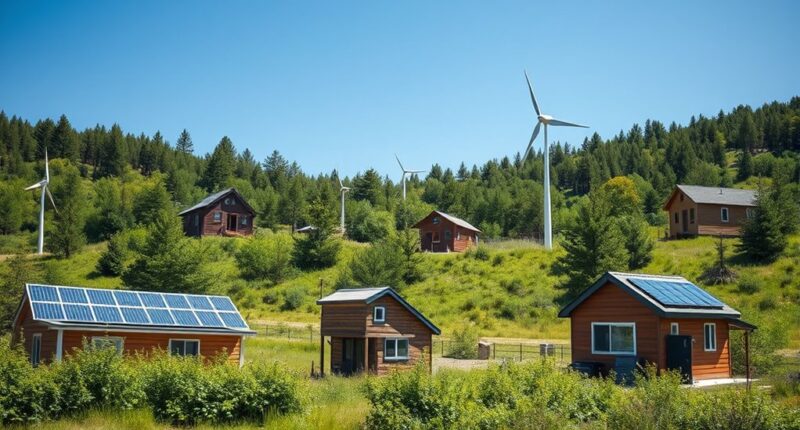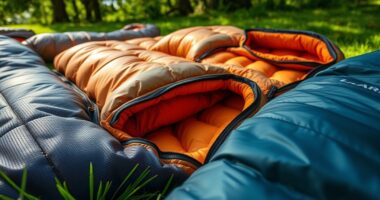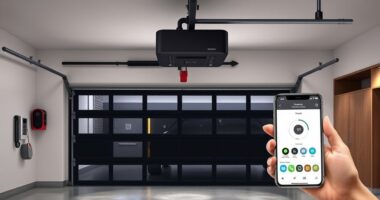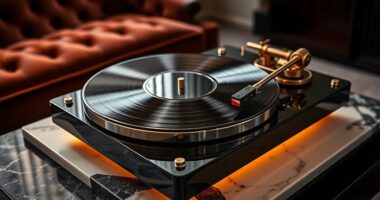If you’re looking for reliable, sustainable off-grid power options for tiny homes, I recommend considering portable power stations like the DieHard 1000-Watt or 300W units, which support multiple devices and quick charging. Pair these with high-efficiency solar kits such as the ECO-WORTHY 7.168KWH system, which includes batteries and a robust inverter. Additionally, a backup UPS or smaller portable units like ALLWEI provide extra safety and convenience. Keep exploring, and you’ll find the perfect setup for your needs.
Key Takeaways
- Combining high-capacity solar kits with battery storage ensures continuous, renewable power for tiny homes off-grid.
- Selecting portable power stations with multiple charging options provides reliable backup for essential devices.
- Using durable, high-cycle lithium batteries enhances system longevity and sustainability in off-grid environments.
- Proper system design includes assessing total energy needs and integrating solar, battery, and inverter components.
- Choosing weather-resistant, expandable systems supports long-term reliability and scalability for tiny home living.
DieHard Portable Power Station 1000-Watt (2000-Watt Peak)

If you’re looking for a reliable, portable power solution for off-grid tiny homes, the DieHard Portable Power Station 1000-Watt stands out. It packs a 999Wh lithium-ion battery that delivers 1000 Watts continuous power, with a peak of 2000 Watts. Weighing just 19.5 pounds and compact in size, it’s easy to carry and set up anywhere. It supports multiple charging options like solar panels, AC outlets, and car chargers. With a pure sine wave output, it’s safe for sensitive electronics. Plus, its safety features and weather-resistant design guarantee durability and peace of mind, making it an excellent choice for reliable off-grid power.
Best For: those seeking a reliable, portable power source for off-grid tiny homes, outdoor adventures, or emergency backup that can handle sensitive electronics and multiple devices.
Pros:
- Lightweight and compact design weighing only 19.5 pounds for easy portability
- Supports multiple charging options including solar panels, AC outlets, and car chargers
- Provides clean, pure sine wave power ensuring safety for sensitive electronics
Cons:
- Limited to 999Wh capacity, which may not be sufficient for extended off-grid use
- May require additional solar panels for faster recharge times
- Higher initial cost compared to smaller or less versatile portable power options
DieHard Portable Power Station 300W (600W Peak) 288.6Wh
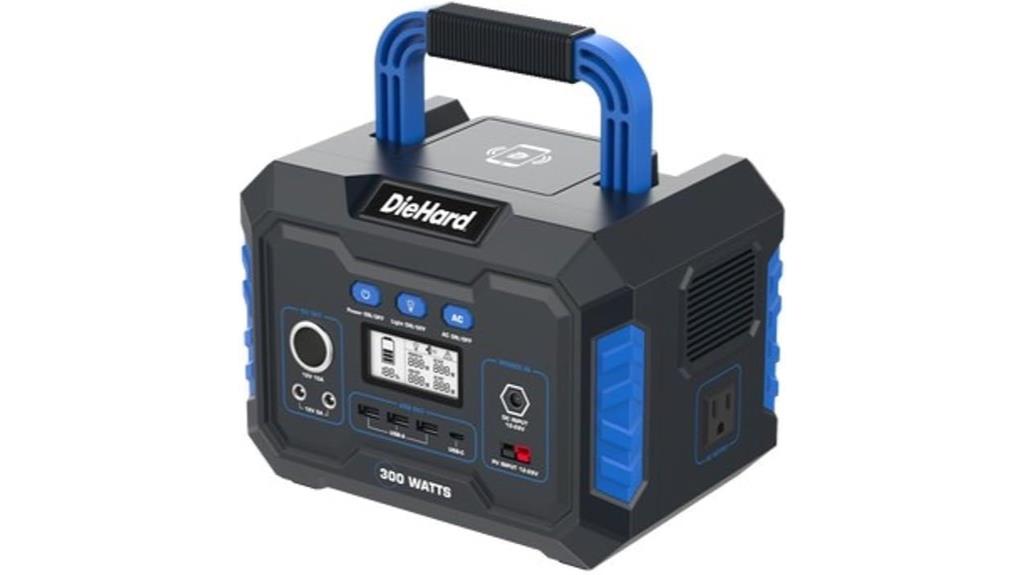
The DieHard Portable Power Station 300W (600W Peak) is an excellent choice for tiny home enthusiasts seeking reliable off-grid power, especially since its compact design and lightweight build make it easy to move and set up wherever needed. With a 288.6Wh lithium-ion battery, it delivers 300W continuous power and up to 600W peak, powering laptops, lights, fans, and small appliances. Its versatile input options include solar, AC, and car charger, while output features include USB, USB-C, DC, and a wireless charging pad. Built to withstand weather and equipped with safety protections, it offers a dependable, eco-friendly power solution for remote living or emergencies.
Best For: outdoor enthusiasts, tiny home dwellers, and emergency preparedness individuals seeking reliable, portable power with versatile charging options.
Pros:
- Compact, lightweight design for easy portability and outdoor use
- Multiple input and output options including solar, AC, USB, and wireless charging
- Built-in safety protections and weather resistance enhance durability and reliability
Cons:
- Limited battery capacity of 288.6Wh may require multiple units for extended power needs
- No batteries included with the single-unit purchase, requiring separate acquisition
- Limited to 300W continuous power, which may not support larger appliances
ECO-WORTHY 7.168KWH Solar Panel Kit with Batteries and Inverter

For tiny home enthusiasts seeking reliable off-grid energy, the ECO-WORTHY 7.168KWH Solar Panel Kit stands out with its high-efficiency bifacial panels and complete components. It includes four 200W solar panels with 25.2% efficiency, a 3000W inverter charger, two lithium batteries, and a Bluetooth-enabled MPPT controller. Designed for easy installation, it supports powering essential appliances like refrigerators, microwaves, and TVs with up to 7.168 kWh of stored energy. Capable of producing 3.2 kWh daily with four hours of sunlight, it offers a sustainable, long-term solution that’s perfect for RV adventures or tiny homes seeking dependable off-grid power.
Best For: off-grid tiny home and RV enthusiasts seeking reliable, high-efficiency solar power with easy installation and ample energy storage.
Pros:
- High-efficiency bifacial solar panels with 25.2% efficiency for maximum power generation
- Complete kit including batteries, inverter, MPPT controller, and Bluetooth monitoring for a seamless setup
- Supports powering a wide range of essential appliances with a large 7.168 kWh storage capacity
Cons:
- Relatively heavy and large components requiring adequate space for installation
- May require basic electrical knowledge for proper setup despite being novice-friendly
- Limited to approximately 3.2 kWh daily production with 4 hours of sunlight, which may be insufficient in low sunlight conditions
600W Portable Power Station with 599.4Wh Battery and Solar Generator
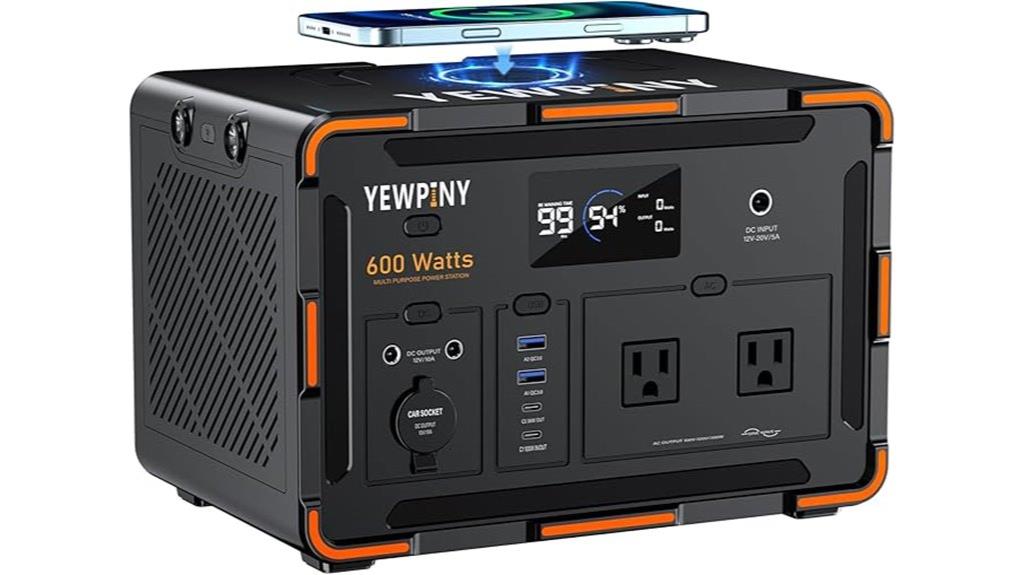
A portable power station like the EM600 is ideal for tiny home owners who need reliable, off-grid energy without the bulk of traditional generators. It features a 599.4Wh battery, providing ample power for essential devices, with a 600W maximum wattage suitable for small appliances and electronics. Equipped with PD100W fast charging, an LCD display for real-time info, and over 2000 charge cycles, it’s built for long-term use. Its compact size (7.72 x 6.92 x 6.46 inches) makes it highly portable. As a solar generator, it can harness renewable energy, ensuring sustainability and independence for your off-grid lifestyle.
Best For: Tiny home owners and outdoor enthusiasts seeking reliable, portable off-grid power for essential devices and small appliances.
Pros:
- Compact and lightweight design (7.72 x 6.92 x 6.46 inches) for easy portability
- High-capacity 599.4Wh battery with over 2000 charge cycles ensures long-term use
- Fast PD100W charging and real-time LCD display for convenient monitoring and quick power replenishment
Cons:
- Customer ratings are mixed, with an average of 3.2 out of 5 stars based on reviews
- Batteries are not included, requiring additional purchase for complete setup
- Limited outlets (only 2) may restrict simultaneous device charging for multiple high-power devices
ALLWEI 256Wh Portable Power Station with Solar Generator and 110V AC Outlet
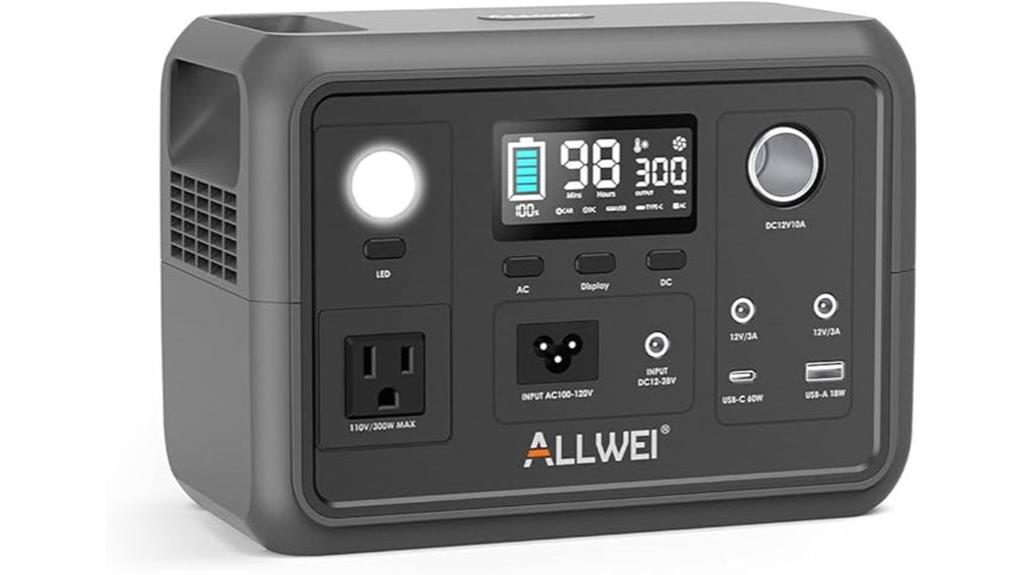
If you’re seeking a reliable, portable power solution for off-grid tiny home setups, the ALLWEI 256Wh Portable Power Station stands out with its compact design and versatile charging options. Weighing just 6.4 pounds and measuring roughly 9.25x5x6.8 inches, it’s easy to carry anywhere. It supports multiple devices, including laptops, phones, mini-refrigerators, and lights, thanks to its AC outlet, USB-C PD 60W, and DC ports. Charging is quick—fully in about 2 to 2.5 hours via solar, car, or wall socket. Its high-quality LiFePO4 batteries and advanced safety features guarantee safe, long-lasting operation, making it ideal for outdoor adventures or emergency power needs.
Best For: outdoor enthusiasts, emergency preparedness, and tiny home owners seeking reliable portable power with quick charging capabilities.
Pros:
- Compact and lightweight design (6.4 lbs, 9.25x5x6.8 inches) for easy portability
- Supports multiple devices simultaneously with various ports, including USB-C PD 60W and AC outlet
- Fast recharge time of 2-2.5 hours via solar, car, or wall socket with high-capacity LiFePO4 batteries for safety and longevity
Cons:
- Solar panel sold separately, requiring additional purchase for solar charging
- Limited capacity (256Wh) may not power larger appliances for extended periods
- No built-in Wi-Fi or app connectivity for remote monitoring
600VA/360W UPS Battery Backup and Surge Protector
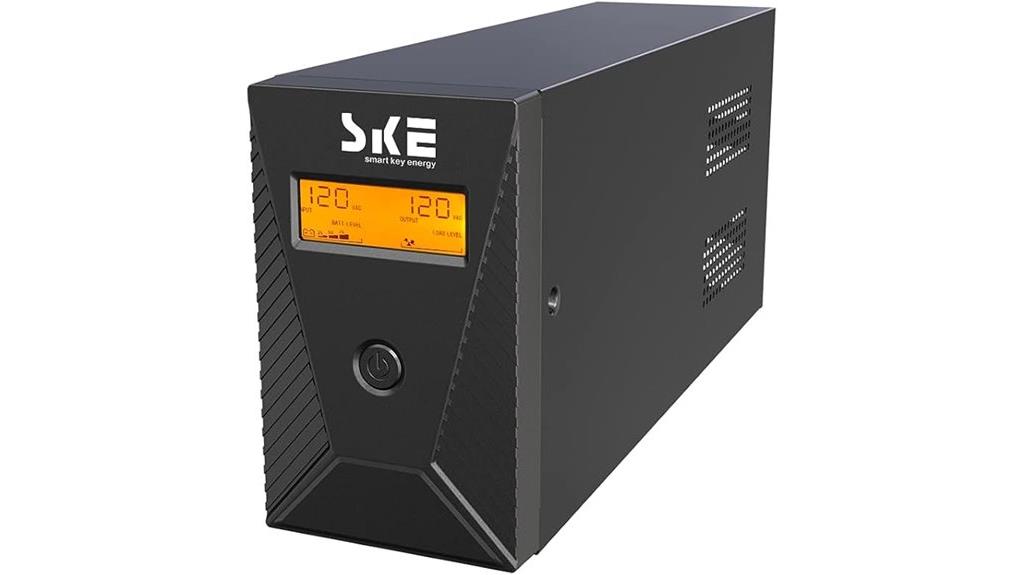
The 600VA/360W UPS Battery Backup and Surge Protector is an excellent choice for tiny home enthusiasts who need reliable, stable power for their essential electronics. It safeguards devices like computers, routers, and entertainment systems with automatic voltage regulation, ensuring consistent power even during surges or dips. With six outlets offering battery backup and surge protection, plus two surge-only outlets, it provides versatile coverage. Its intelligent LCD displays real-time status, and the cooling fan handles high power needs quietly. Easy to manage, it also features software for unattended shutdowns. This UPS offers peace of mind, keeping your critical electronics protected and operational during power fluctuations or outages.
Best For: tiny home enthusiasts seeking reliable, stable power for essential electronics like computers, routers, and entertainment systems.
Pros:
- Provides automatic voltage regulation to protect devices from surges and dips
- Features an intelligent LCD display for real-time status updates
- Includes a cooling fan for quiet operation during high power demands
Cons:
- Limited to 600VA/360W capacity, may not support high-power equipment
- Beeping alerts can be disruptive if not silenced manually
- Only six outlets offer battery backup and surge protection, which might be insufficient for multiple devices
Factors to Consider When Choosing Off-Grid Power Setup for Tiny Homes

When choosing an off-grid power setup for a tiny home, I consider my actual energy needs and how much power my appliances require. I also look at the system’s portability, size, and whether renewable options like solar or wind are practical for my location. Finally, I prioritize battery capacity, safety, and reliability to guarantee consistent power and peace of mind.
Power Needs Assessment
Ever wondered how to accurately determine your tiny home’s energy needs before choosing an off-grid power setup? The key is to list all appliances and devices, then add up their wattage and daily usage hours to find your total energy consumption. Don’t forget to include a buffer of 20-30% to cover unexpected loads or future equipment additions. Pay special attention to appliances with high starting wattage, like refrigerators or power tools, as they draw more power initially. It’s also vital to assess your battery capacity to guarantee it can handle your daily energy needs reliably. Finally, evaluate your renewable energy input, such as solar panel wattage and sunlight hours, to confirm your system can generate enough energy to meet and replenish your consumption consistently.
Portability and Size
Choosing the right off-grid power setup for your tiny home means considering both portability and size to guarantee it fits your lifestyle and space constraints. I recommend looking for compact power systems that weigh less than 20 pounds for easy transport and quick setup. Make sure the unit’s size fits comfortably within your limited space, whether that’s under furniture, in closets, or storage areas. Devices with integrated carrying handles are a big plus, especially if you plan to move or take your system outdoors often. Keep a balance between size and capacity to ensure your system can meet your energy needs without becoming bulky or difficult to manage. Ultimately, a portable, space-efficient setup makes off-grid living more convenient and adaptable to your changing needs.
Renewable Energy Options
Selecting the right renewable energy sources for your tiny home depends on several key factors. Solar panels are the most common choice, especially high-efficiency bifacial panels that reach up to 25.2% efficiency, maximizing energy production in limited space. If you live in a windy area, wind turbines can supplement solar, providing power during cloudy days or at night. For locations near flowing water, micro-hydro systems are a reliable, consistent source with minimal environmental impact. It’s also vital to take into account energy storage; lithium-ion or LiFePO4 batteries store excess energy for use during low sunlight or wind. Finally, integrating these sources with smart energy management systems guarantees ideal power usage, making your tiny home truly sustainable and self-sufficient.
Battery Capacity and Longevity
When designing an off-grid power system for a tiny home, understanding battery capacity and longevity is vital because these factors directly affect how long your appliances can run without needing a recharge. Battery capacity, measured in watt-hours (Wh), determines your total available energy and influences how long your systems can operate before a recharge is necessary. High-quality batteries like LiFePO4 offer 2,000 to 3,500 charge cycles, providing years of reliable service. Larger capacities extend your power availability but also add weight, size, and cost. To maximize lifespan, it’s essential to manage the depth of discharge (DOD) and maintain ideal conditions—temperature, charge/discharge rates, and regular maintenance—all of which markedly influence the longevity of your batteries.
Safety and Reliability
A reliable off-grid power setup depends on more than just capacity; safety features and dependable components are key to protecting your tiny home and devices. I look for systems with overcharge protection, short-circuit prevention, and temperature regulation to safeguard both the system and connected electronics. Choosing high-quality lithium-ion or LiFePO4 batteries ensures reliability, offering over 2,000 charge cycles and a long lifespan. I prefer inverters that produce pure sine wave output, which prevents damage to sensitive electronics and provides stable power. Incorporating automatic shutdowns and emergency cutoffs minimizes risks during malfunctions or surges. Regular maintenance and monitoring of batteries and connections help prevent failures and keep the system operating safely and consistently. Safety isn’t optional—it’s essential for peace of mind and system longevity.
Frequently Asked Questions
How Long Can a Portable Power Station Run Essential Appliances?
A portable power station can run essential appliances for several hours to days, depending on its capacity and the power draw of your devices. For example, a 500Wh unit might power a fridge for 8-10 hours or charge phones and laptops for multiple days. I always consider my energy needs and the station’s capacity to guarantee I have reliable power when off-grid.
What Are the Maintenance Requirements for Off-Grid Solar Setups?
Think of off-grid solar setups like a garden—they need regular care to thrive. I check my panels for dirt or debris monthly, make sure batteries are topped up and balanced, and replace worn-out components when needed. I also keep an eye on inverter performance and monitor system outputs to catch issues early. Consistent maintenance keeps my solar setup reliable, efficient, and sustainable, so I can enjoy clean power off the grid.
Can These Systems Handle High-Energy Appliances Like Air Conditioners?
Yes, these systems can handle high-energy appliances like air conditioners if I size my solar panels, batteries, and inverters correctly. I make certain to calculate the energy demand accurately and choose equipment with enough capacity. Proper system design, including a generous margin, helps me run such appliances reliably without overloading my setup. Regular maintenance and monitoring also ensure consistent performance during hot days.
How Scalable Are Portable Power Stations for Future Energy Needs?
Portable power stations are quite scalable, and I love how I can expand my setup as my energy needs grow. I start with a solid base, then add extra batteries or solar panels to boost capacity. This flexibility means I don’t have to overhaul my entire system whenever I want more power. Plus, I can take my station on the go, making it perfect for evolving off-grid lifestyles.
What Safety Precautions Should Be Taken With Off-Grid Power Systems?
Think of off-grid power systems as the heart of your tiny home—vital and delicate. I always wear gloves when handling batteries, guarantee proper ventilation, and keep fire extinguishers nearby. Regularly check wiring and connections, use surge protectors, and avoid overloading circuits. Just like a seasoned sailor respects the sea, I respect my system’s limits, prioritizing safety to keep my energy flowing smoothly and securely.
Conclusion
Choosing the right off-grid power setup is vital for tiny homes. Did you know that solar energy accounts for over 40% of all renewable power worldwide? With reliable options like portable stations and solar kits, you can enjoy sustainable, independent living. I’ve found that combining solar panels with battery backups offers the best balance of reliability and eco-friendliness. Ultimately, your choice depends on your energy needs and budget, but these setups make off-grid living more achievable than ever.
